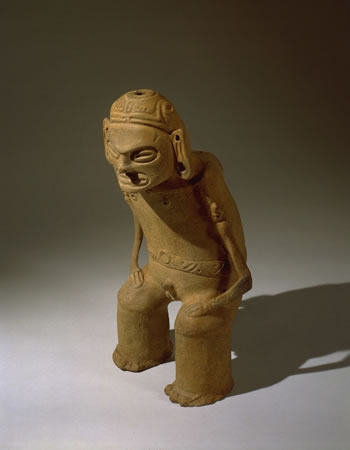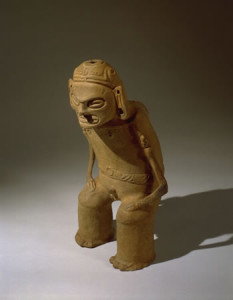Exploring Indigenous Legacies

 By Eduardo Diaz, Director, Smithsonian Latino Center
By Eduardo Diaz, Director, Smithsonian Latino Center
In 1662, William Sanderoft, the Archbishop of Canterbury, approved the Jamaican coat of arms, depicting an “Arawak” couple: she holding a food basket, he holding a bow. Below the couple, the inscription: INDVS VTEQVE SERVIET VNI, “The two Indians will serve as one,” perfect for implying the collective servitude the British expected of the Natives and, later, African slaves. As we know, the Native populations of Jamaica, derived from the Taíno words yamaye and xaymaca (land abounding with springs), were devastated by the arrival of European colonists.
Last summer, I attended a presentation by Lesley-Gail Atkinson, an archaeologist from the Jamaica National Heritage Trust, who was in Washington, D.C. for a workshop exploring indigenous legacies of the Caribbean, co-hosted by the Smithsonian’s National Museum of the American Indian and Latino Center. A portion of the presentation, based on her seminal work, The Earliest Inhabitants: The Dynamics of Jamaican Taíno, focused on Afro-Indigenous miscegenation — from how Taíno communities protected Maroon* leaders Nanny and Cudjoe, to the indispensability of Taíno ingredients, ají (native hot pepper) among them, in Jamaica’s famous jerk barbeque (from the Taíno, barbacoa.) A fascinating part of Dr. Atkinson’s presentation detailed the stunning failure of a plebiscite to change the Jamaican coat of arms. Proponents advocated the replacement of the Native pair with an African couple, owing to the island’s overwhelming African-descended population, but they underestimated Jamaicans’ own identification with the island’s First Nation.
Also participating in the same work session was Rachel Beauvoir-Dominique, a Haitian scholar, who explained how traditional Vodou practice incorporates Taíno objects and religious cosmology. It is significant that in Haiti (from the Taíno Ayiti, land of high mountains), as in Jamaica, reverence for indigenous past and contributions is vigorously acknowledged and preserved.
In addition to the above-mentioned scholars, we also invited experts from the Dominican Republic, Puerto Rico, Cuba and Belize, the latter acknowledging the cultural, particularly linguistic, connection between the Taínos and contemporary Garífuna peoples. Importantly, cultural workers involved in recovering Caribbean indigenous identity also participated in this workshop, some of whom identify as Afro-Indigenous. Their participation was important for two reasons: 1) in addition to researching their indigeneity, they strive to live it, actively practicing rituals and gathering as community; and 2) researching Afro-Indigenous miscegenation is important in comprehending Caribbean indigenous histories.
Exploring indigenous legacies of the Caribbean is a sensitive endeavor, because of the presumed extinction theories subscribed to in some academic and community quarters. The Smithsonian has custody of over 9,000 objects of Taíno derivation, and in preparing to responsibly share the collection with the public we are doing our homework, aided by a diversity of scholarship and manifestations of lived experience. The Smithsonian’s mission is to increase and diffuse knowledge, and to tell, not spin, stories.
I recently returned from Santo Domingo, Dominican Republic, where a Smithsonian team conducted a consultation with leading Taíno scholars, activists, and collectors. We were amazed by the focused, enthusiastic response to our initiative, and were enriched by their perspectives and ideas. Later, our research leaders conducted consultations in San Juan de la Maguana and Altos de Chavón, where the sense of Taíno community is more present. I’m told the response was more powerful and personal. My sense is that our initiative is touching a deep chord, one that goes to essence of identity and being.
When last in Chicago, I went to a bombazo, a community performance of traditional Puerto Ricanbomba, a percussive music and dance genre born in African slave quarters. One of the young musicians proudly sported a t-shirt that read, “Taíno Strong.” This memory surfaced as I listened to the presentations of our invited Caribbean scholars and activists and took in the feedback in Santo Domingo, reminding me of the miscegenation of peoples and cultures that have shaped the American continent since First Contact. I think it is important to follow the beat, and the storyline, no matter where they lead.
*Maroon: derived from the Spanish Cimarrón (living on the mountaintops), is a name given to fugitive African slaves. The British seized Jamaica from the Spanish in 1655. Rather than be re-enslaved by the British, groups of runaway slaves formed and rebelled, clearing an initial path for independence. Nanny and Cudjoe were two prominent Maroons, considered national heroes.
Eduardo Díaz is the director of the Smithsonian Latino Center and a 30-year veteran of arts administration. The Latino Center works to increase and enhance Latino presence, research and scholarship at the Smithsonian Institution by sponsoring, developing and promoting exhibitions, collections, research and public programs that focus on the Latino experience. Díaz is an advisor to the Smithsonian’s Secretary and Under Secretary for History, Art and Culture as well as to Congress and other government agencies on a range of cultural development issues related to Latino communities in the United States and their impact on diverse countries of origin.
[Photo courtesy National Museum of the American Indian]
